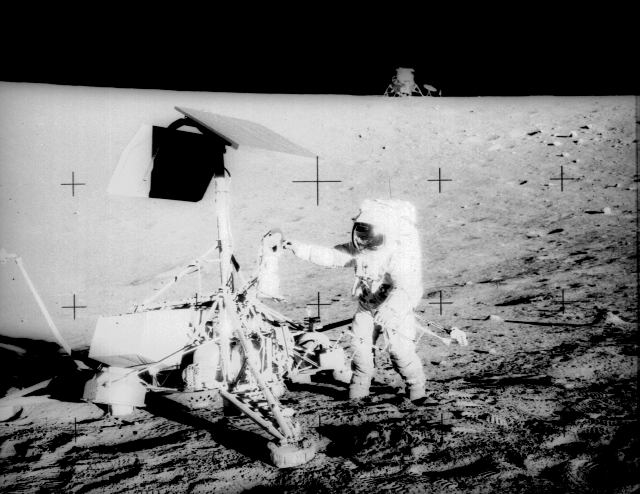The Apollo lunar landing missions were numbered 11-17. If you saw the movie, you already know that Apollo 13 wasn't able to land on the Moon, so all we have to think about are the remaining missions: 11,12, 14, 15, 16, and 17.
Everybody knows that Apollo 11 landed in the Sea of Tranquility, and we'll get into more detail about that shortly. Let's split the remaining missions after Apollo 11 into "odds" and "evens" :
So, we've got the even-numbered missions on the lower left, the odd-numbered missions up above, and the Apollo 11 mission right in the middle as sort of a "divider." It's funny, but the layout is pretty darned close to how the actual landings occurred back then.
You know where Apollo 11 landed, right? "Tranquility Base," on the Sea of Tranquility. Let's go back to the Moon map and look at the Sea of Tranquility again:
As you remember, it's right in between the Seas of Serenity and Fertility, right? (STuF). The Sea of Tranquility straddles the Moon's equator, which is fortunate, because Apollo 11 relied on an equatorial orbit when it arrived at the Moon. Landing on the equator would make things a lot easier for fuel consumption and communications back to Earth, so Mission Control picked out a smooth spot on the Sea of Tranquility that's right on the equator. Let's look at the map with an equator drawn on it so you can see where the landing was:
See? Right on the equator, at the bottom left corner of the Sea of Tranquility is where Neil Armstrong and Buzz Aldrin landed. All you have to do to find the landing site when you're looking at the Moon is to find the Sea of Tranquility (which you know how to do already) and then look at the 7 o'clock position of the mare - - THAT'S Apollo 11.
Let's go on to the next two landings, 12 and 14. Both of these ships landed in what's called the "Known Sea" or Mare Cognitum. The reason the sea was named the "Known Sea" is because so many lunar missions (manned and unmanned) arrived on this expanse of flatlands on the west side of the Moon. In fact, part of Apollo 12's mission was to set down next to an earlier unmmaned probe named Surveyor 3, a feat which Pete Conrad and Al Bean achieved in November of 1969:
The landing site for Apollo 12 was right where the Known Sea bumps into the Ocean of Storms, just south of the equator:
Once again, we skip over Apollo 13 because that mission didn't put anyone on the Moon, thank goodness. The next mission, Apollo 14, landed on the east side of the Known Sea, next to a huge, ancient crater called Fra Mauro. This mission was also south of the equator:
The final three Apollo missions were much more ambitious. While the earlier missions were near the equator and aimed for smooth, flat landing targets, the later Apollos were sent to the highlands of the Moon. The Apollo 15, 16, and 17 crews were outfitted with larger fuel capacity LMs, to fly further away from equatorial sites and carry more gear to the surface. They even had lunar rover vehicles with them to extend their surface activity areas.
I'm going skip Apollo 15 for a moment so we can finish up the even-numbered flights. Apollo 16 landed in a highland area almost 10° south of the equator, near a rugged crater named Descartes. If you draw a line straight south from the bottom of the Sea of Serenity, the Apollo 16 landing site is about even with the north side of the Sea of Nectar:
Apollo 15 and Apollo 17, the only missions north of the equator, have easy-to-remember landing sites because they both landed next to the Sea of Serenity. Apollo 15 set down in-between the Sea of Showers and the Sea of Serenity, in an area called the Hadley-Apennine Mountains. It's really easy to spot if you look right at the middle of the northern half of the Moon.
The final mission landing site, Apollo 17, is as easy to spot as Apollo 15's locale, because it's also stuck at the intersection of two maria. In this case, Apollo 17 landed in the Valley of Taurus-Littrow, where the Sea of Serenity bumps into the Sea of Tranquility:
And that's it! Just remember that Apollo 11 landed on the equator, all the even-numbered Apollos after that landed to the south and west, and all the odd-numbered missions landed to the north around the Sea of Serenity.
The crew of Apollo 17 left the Moon in December of 1972, and nobody's been back since. Hopefully there will be more landing sites to memorize soon, instead of just the six dots that mark mankind's furthest steps away from Earth.





































